Stay connected
Subscribe to our Inside WEX blog and follow us on social media for the insider view on everything WEX, from payments innovation to what it means to be a WEXer.
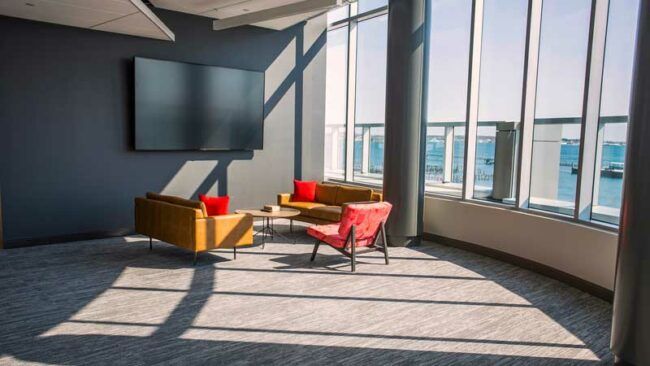
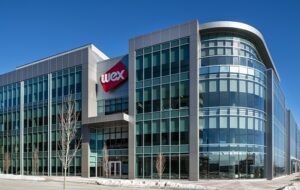
Exterior shot of WEX headquarters in Portland, Maine
When you think about the way most of us live our lives, the majority of our waking hours are spent at work. How we feel when we think about that space, how we visualize it as we make our way to work and how we experience it while we’re there has a profound impact on our wellbeing. For those of us with the luxury of having some measure of choice in where we work, does the aesthetic of a potential place of employment play a role in where we decide to land?
What are employees looking for in a workspace today? What features will attract them to work for your company and stay working there? There are new answers to these questions that might surprise you.
Architects who design office space are today hyper-focused on two new design philosophies: WELL building and Activity Based Working (ABW). According to SMRT’s Jeana Stewart, lead interior designer for WEX’s new HQ, architects are dedicated to creating healthy workplaces and this overarching focus on wellness is here to stay.
WELL building is a system for measuring, certifying and monitoring building features that impact human health and well-being. It focuses on how air, light, sound, community, water, movement, materials, innovation, nourishment, thermal comfort and mind impact the user experience in a building. WELL architects design workplaces with the primary goal of employee comfort and health. As the WELL building site puts it: “WELL Certified spaces can help create a built environment that improves the nutrition, fitness, mood, sleep patterns, and performance of its occupants… WELL is about the effect of the environment on the individual, both physiologically and psychologically.”
ABW is also focused on employee wellness with movement as the thrust of its philosophy: give employee opportunity and encouragement to move throughout the day. According to the Fellowes Workplace Wellness Trend Report, 87% of workers are looking for healthier workspaces and 93% of workers in tech said they’d stay longer at a company that offered healthier workplace benefits.
As an article in Influencive puts it, “Sitting behind a desk is giving us a 90% higher risk of developing diabetes, an 18% higher chance of dying of heart disease or cancer, and a 40% higher chance of dying prematurely.” And according to the American Heart Association, nearly 80 million U.S. adults are clinically obese. Creating opportunities to encourage employees to move away from their desks helps combat these health challenges.
Movement at the new WEX headquarters is addressed by providing a wide range of choices for where to work and encouraging employees to take advantage of these choices. The choices include multiple options for hosting a meeting with others, places like high backed enclosed lounge chairs that look out onto Casco Bay or downtown Portland for a private space to focus, and pods where employees can simply step away from a desk to talk with a small group about a project. With an open plan workspace, it’s important to give employees access to private, quiet space. All employees have height adjustable (sit/stand desks) workstations which also encourages movement and changing one’s position.
Influencive goes on to say, “The average American sits 9.3 hours every day between work and relaxing at home.” As interior designer Jeana Stewart describes, “The bigger picture is really being able to move away from your desk. We are giving people the opportunity to be able to work in places that are away from their desk so that they can get up and move throughout the day and change their posture.”
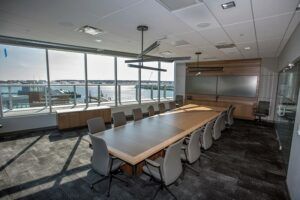
WEX headquarters in Portland, Maine
In a recent HBR study on employee wellness, fifty percent of survey respondents said they would work and feel better with some view of the outdoors, which makes perfect sense when you think about it. We all have a circadian rhythm – which is your body’s internal clock telling you it’s daytime or nighttime. Having access to natural light ensures awareness of time of day and helps sleep patterns. Better sleep patterns directly impact wellness. The WEX HQ building was constructed with exterior walls of glass and makes the best use of natural light, ensuring employees can stay aligned with their inner clocks.
A recent study at Cornell University found that “optimization of natural light in an office significantly improves health and wellness among workers…research revealed that workers in daylight office environments reported a 51% drop in the incidence of eyestrain, a 63% drop in the incidence of headaches and a 56% reduction in drowsiness.”
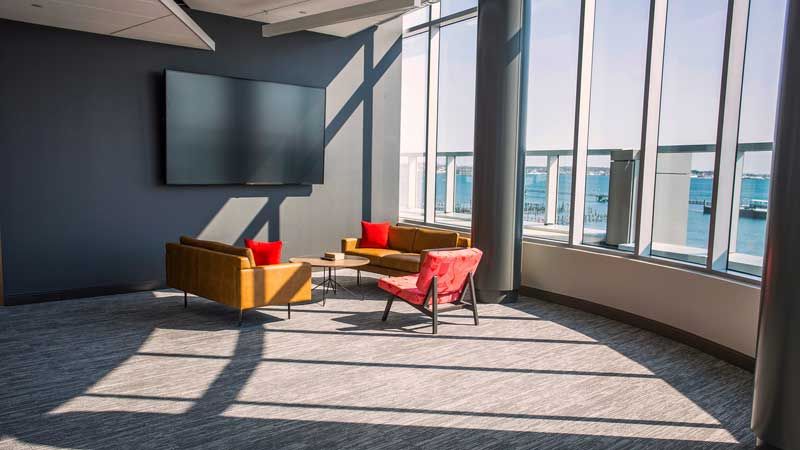
Natural light and scenic views from windows at WEX headquarters in Portland, Maine
Not only did WEX build a glass perimeter on its new building, it also implemented a cultural shift to improve light quality for the majority of its employees housed at this facility. When the company moved into the new building, the number of private offices held by individuals was reduced to allow more people access to natural light, ocean views and cityscape views. Additionally, most of those who retained private offices were given space in the middle of the building instead of on the outside walls. If you look at the floor plan below, you’ll see how this works.
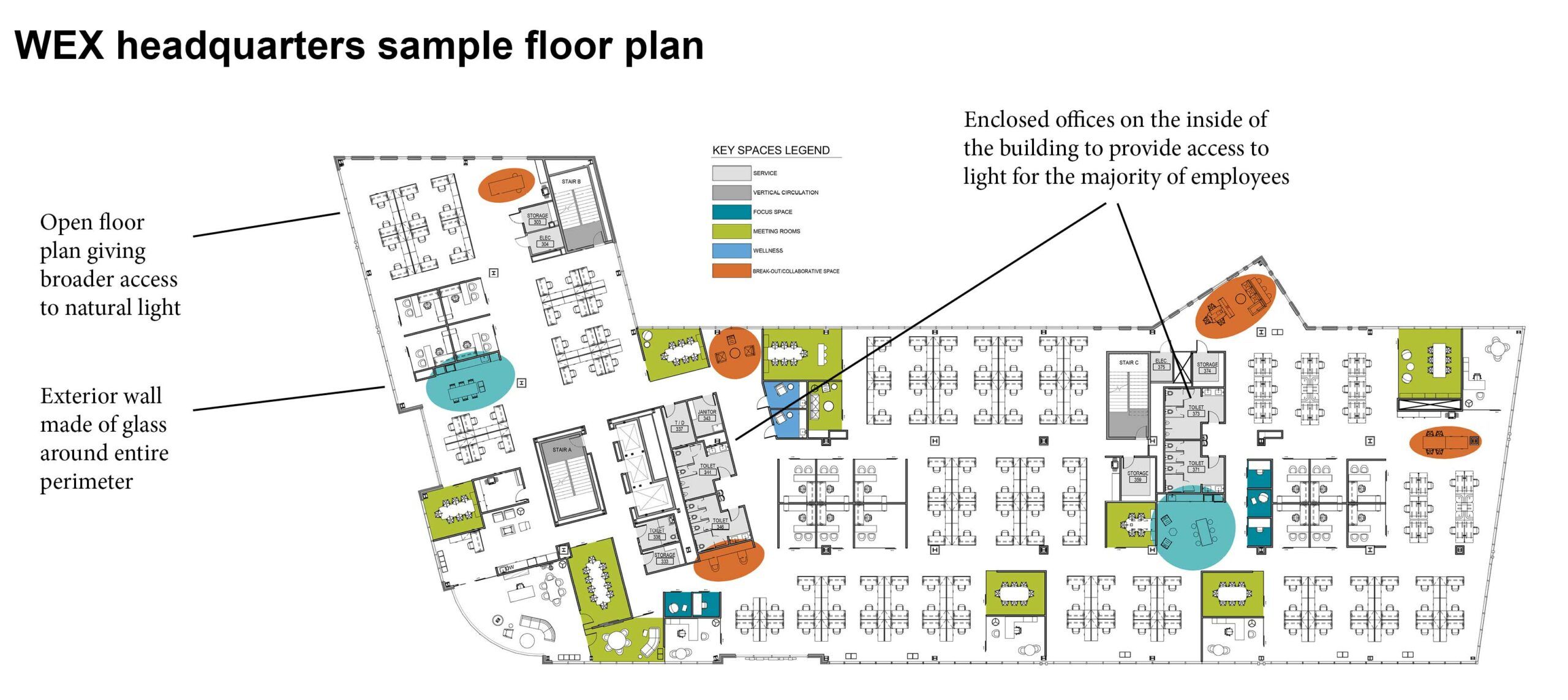
Floor plan of WEX headquarters in Portland, Maine
Light-filtering window treatments were used to help prevent eye strain. And the shades are on a timer that is set for them to raise and lower at different times during the day based on where the sun sits in the sky. This allows for maximum benefit in how much light is flowing in and ensuring there is never a glare or uncomfortable amount of light streaming in at any given point in the day.
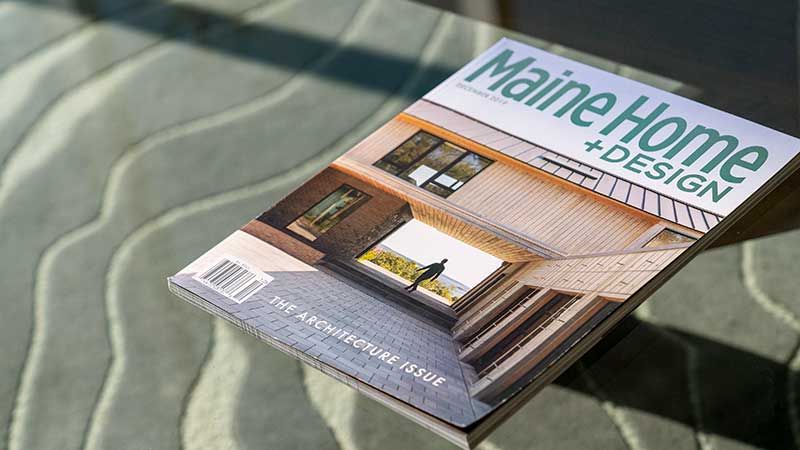
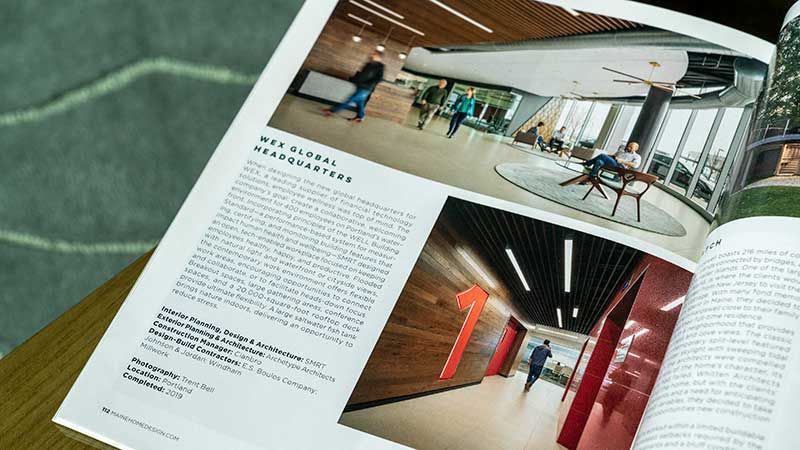
WEX headquarters featured in Maine Home + Design article “Machines for Living”
Malcolm Gladwell wrote an essay for The New Yorker, “Designs For Working” in 2000, that made the case for open plan offices, which “exchange private space for public space.” Gladwell posits that innovation is fundamentally social. He says “Ideas arise as much out of casual conversations as they do out of formal meetings.” Open workspace at WEX provides for more natural light for a larger number of people while also providing for more interaction across functional lines of business and thus a greater likelihood for innovation to happen.
A recent study conducted by the Harvard Business Review found that “employees want the basics first: better air quality, access to natural light, and the ability to personalize their workspace. Half of the employees we surveyed said poor air quality makes them sleepier during the day, and more than a third reported up to an hour in lost productivity as a result. In fact, air quality and light were the biggest influencers of employee performance, happiness, and wellbeing.”
Another Harvard study on employee wellness found that “improved air quality caused mental cognition to soar.” And in a recent Harvard Business Review study, the number one environmental factor cited when employees were surveyed about workplace wellness was wanting better air quality. Fifty-eight percent of respondents said that fresh, allergen-free air would improve their wellness.
WEX and Stewart used materials with the lowest possible Volatile Organic Compounds (VOCs). In the wood-look product in kitchen areas, the concrete-look product in the breakroom area, and paint used throughout the building the focus was on not emitting harmful chemicals. WEX also chose carpets where the materials inherent in the carpet materials, the nylon, and the backing system, were engineered so as to not off-gas chemicals. There was also a focus on developing an HVAC where the interior of the building was getting plenty of air exchanges with the outside air.
A Harvard Business Review study found that “Noise distractions bothered more than a third of those surveyed, impacting their ability to concentrate. Employees said sounds like phones ringing, typing on keyboards, and distractions from coworkers all impacted their concentration.” There is purposeful white noise in the new WEX building so that kind of ambient sound helps make people’s voices distorted enough so that you can’t hear specific conversations. You’re less likely to be distracted honing in on somebody’s exact words. It’s just kind of a buzz. This is important in an open floor plan like at WEX, where collaboration can sometimes lead to increased noise levels.
Why has drinking water all day long become such a craze? Because ingesting water helps our body in myriad ways: carrying nutrients and oxygen to your cells, normalizing blood pressure, and cushioning joints, are a few examples. Employees at WEX have ready access to fresh drinking water and it was important to the company to be a steward environmentally, which meant not providing bottled water, but rather providing an abundance of places to fill an empty water bottle. Stewart was strategic about sourcing water fountains that were accessible and charting their locations to be easy to find and use throughout the building.
How does it feel to spend time in nature? What does it do for a person’s wellbeing? Harvard Medical School, in a recent article says “research in a growing scientific field called echotherapy has shown a strong connection between time spent in nature and reduced stress, anxiety, and depression.” Studies show that interaction with the natural world can also increase one’s ability to focus and pay attention and refresh our brains for starting a new task. A connection with the natural world makes us feel more a part of the world at large and also to each other.
Design for the WEX HQ incorporated plants, natural wood finishes, and a fish tank in the large break room to give employees that experience. The fish tank is a dynamic element with which employees can engage. Because it’s two-sided it can be experienced from the workspace as well as the break room area. The building also provides ample opportunity to view Maine’s coastline and islands over the course of a workday.
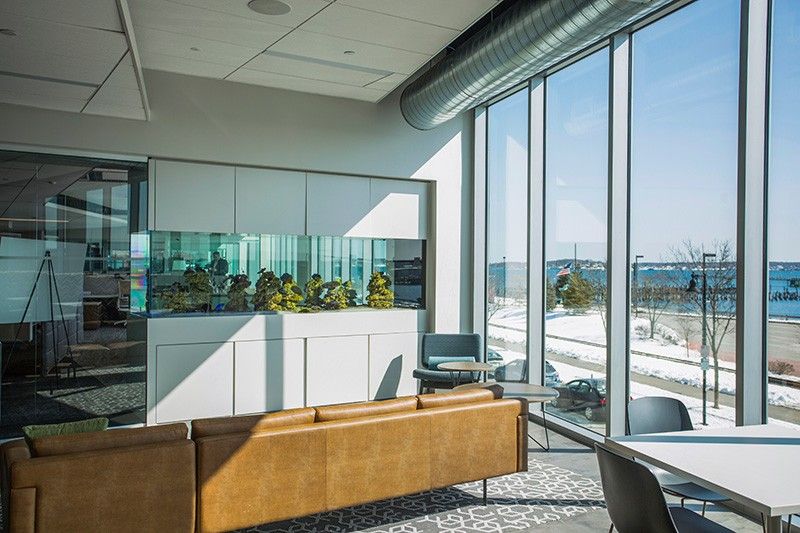
Break room fish tank at WEX corporate headquarters in Portland, Maine
When you leave for work in the morning, do you look forward to seeing your friends at work? Can you feel this positive energy adding a happy spin to heading into the office? That serotonin influx is really good for your health and part of why building community at work is important to companies like WEX. The creation of community at a company is primarily operational, but what WEX did with their new HQ was add some structural and design elements to formalize how much WEX values community.
At WEX’s new corporate HQ, investing in the new rooftop deck with 20,000 plus square feet of space is one prominent example of this. The rooftop deck was built with socializing and after-hours events in mind. There’s cornhole and other fun games to play, an option to work alfresco, internet access, and gorgeous views of Maine islands and Portland’s working waterfront. By creating this kind of fun space at work, WEX is encouraging friendships to develop. Operations-wise the company builds events into the spring, summer and fall calendars to take advantage of the space.
Additionally, the large, open break room space on the 2nd floor places community front and center. There are large tables for bigger groups of friends to share lunch as well as more intimate, private nooks for smaller groups to commune. Community eating spaces encourage WEX employees to make friends at work so work and life are joined in a positive way. Again, these spaces take advantage of natural light and the gorgeous views of ocean and city that the WEX location allows.
Studies show that employees who feel healthier in their workplace have better attention and focus, are happier, and enjoy coming to work. In 1995 Franklin Becker and Fritz Steele released a book, Workplace By Design: Mapping the High-Performance Workscape, which explained how to create a more productive workplace. In the years since the book’s publication, Becker and Steele’s philosophy has been expanded to say that you can design a workplace that boosts productivity and reduces stress. Sherry Burton Ways, author of “Feel Good Spaces: A Guide to Decorating Your Home for Body, Mind And Spirit,” states in Forbes Magazine that “noise, lack of privacy, poor lighting, poor ventilation, poor temperature control, or inadequate sanitary facilities can create a stressful work environment.” Addressing these variables by creating a workspace that invokes WELL and ABW standards will result in more engaged and happier employees.
Research conducted by the Harvard Business Review finds that “employees who are satisfied with their work environments are 16% more productive, 18% more likely to stay, and 30% more attracted to their company over competitors. Two-thirds of our survey respondents said that a workplace focused on their health and wellbeing would make them more likely to accept a new job or keep the job they have.” Companies like WEX, eager to adopt an employee-centric view of workplace design will not only increase productivity, they will also improve their ability to attract and retain talent.
“We knew the move to downtown Portland and this exciting new headquarters would help us attract a wider pool of talent. Then putting strategy, industry experience, and knowledge behind how that structure would impact the employee experience also improved the likelihood we would see an increase in the number of applicants, particularly tech talent, coming to WEX. The question WEXers often get here in Portland is ‘Are you in the downtown office?’ and excitement seems to be abundant about what a great location and facilities we now have here at our headquarters,” says Melanie Tinto, VP of Human Resources at WEX.
Whether you’re planning on erecting a new building, or making some changes to the layout of your existing space, all the research points to employee wellness as the magic bullet. Because we spend so much of our time at work, we all want to work in a place that feels comfortable, and safeguards our health and wellness.
If your workplace can incorporate the tenets of ABW and WELL, you will be progressing towards a more productive and happier workforce. Employees at WEX experience “life” and a sense of wellbeing while at work, which increases their level of satisfaction. If people feel happy and cared for while in the workplace, they’re going to do better work: they’re going to bring their best selves to work every day.
If you’re interested in working for a growing and global organization that puts employee wellbeing first, please visit WEX’s career page.
References: Lifegate, University of Minnesota Taking Charge, Harvard Business Review, Forbes, New Yorker Magazine, Maine Home & Design Magazine, MaineBiz Magazine, Inc., Influencive, Harvard Medical School
Subscribe to our Inside WEX blog and follow us on social media for the insider view on everything WEX, from payments innovation to what it means to be a WEXer.